Cruise Day 47
Speed 5 knots (kts)
Course 152° (SSE)
Location N. Canada Basin, ~539 nm north of Barrow, Alaska
Depth 3862 m
GO DEEPER DISCUSSION: (see previous journal for the questions.)
While splicing is strong and permanent, it takes extra time and tools to accomplish. Knotting is faster, and can be untied later if desired.
TODAY’S JOURNAL:
We concluded our super station and resumed our southerly journey south this morning, with an eye out for suitable ice to conduct another ice sampling station. Three factors worked against us – finding ice of suitable quality (strike one), having good visibility to at least two miles (strike two), and getting these conditions by 10 am (strike three, we’re out.) We’ve been rapidly leaving thick ice behind as we go south, and although coverage is still over 90% of the surface it is pretty thin, much appearing to be the beginnings of this winter’s crop. Visibility has been challenging all day, with steady wind-driven snow pelting through the air and thick clouds providing only very flat light conditions. The 10am provision is to give us enough time to finish up the station before darkness falls. (Now that the equinox has passed we are experiencing significant periods of nighttime, a rapid change from the 24-hour sunlight we had less than a week ago. If you check the Aloft Con web cam (link at the end of each journal post) during nighttime hours you’ll see what I mean!) Failing on all three criteria, there was no ice station today.
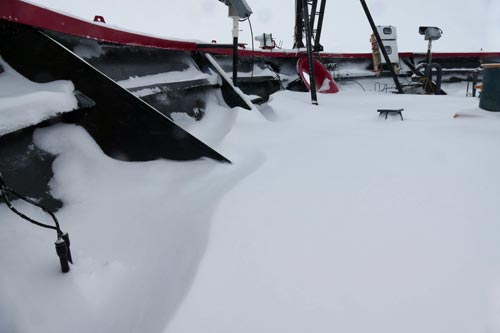 Despite frequent shoveling by the deck crew, some pretty nice snow drifts developed overnight on the bow of USCGC Healy.
Despite frequent shoveling by the deck crew, some pretty nice snow drifts developed overnight on the bow of USCGC Healy.
We did stop mid-morning to place the last of our Float Your Boats. Since the ice wasn’t suitable for walking around, a coast guard crew member put them out from a cage lowered by crane. The first six batches of float boats were left in boxes on prior drop-offs but this time it was decided to scatter the boats out on the ice. I didn’t have the chance to have my students decorate boats, but we had a few undecorated models left in the batch so I made one for my home team, Centennial Middle School in Boulder, Colorado. I christened it the Cyclone after our school mascot and can report that it went onto the ice along with a drift buoy at approx. 80.41° N, 148.58° W. Watch for drift buoy tracks and potential boat recovery reports at http://floatboat.org!
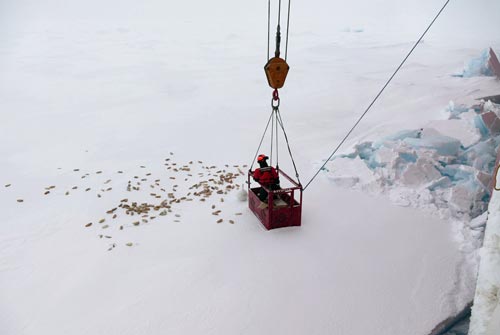 The last batch of Float Your Boats was scattered on the ice along with a drift buoy by a crew member lowered to the surface via ship’s crane.
The last batch of Float Your Boats was scattered on the ice along with a drift buoy by a crew member lowered to the surface via ship’s crane.
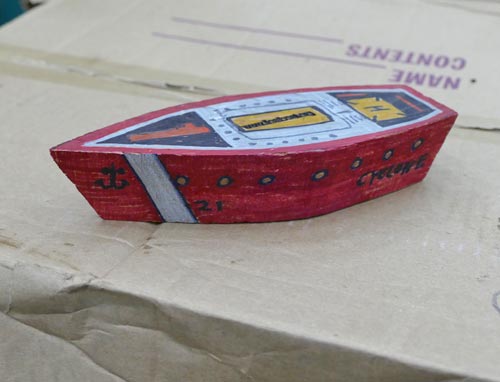 The Cyclone, a Float Your Boat I made for Centennial Middle School, Boulder, Colorado.
The Cyclone, a Float Your Boat I made for Centennial Middle School, Boulder, Colorado.
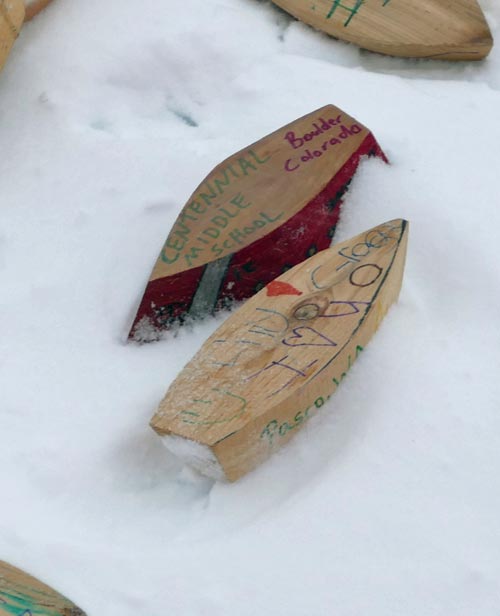 The Cyclone deployed onto the ice at approx. 80.41° N, 148.58° W.
The Cyclone deployed onto the ice at approx. 80.41° N, 148.58° W.
The snowy, windy weather has a neat effect on open water leads. Snow falling into the water doesn’t melt but instead makes a slushy mix. This mix is formed into distinct stripes due to small-scale counter-rotating horizontal tubular currents set up in the surface zone. Called Langmuir circulation, these concentrate the slush where two cells converge (in other areas, seaweed or foamy streaks can accumulate in lines as well.) New ice was piling up rapidly where these lines ran into the edge of leads and the slush accumulated and froze together. Check out Wikipedia or do an online search for examples and further explanation of this neat phenomenon.
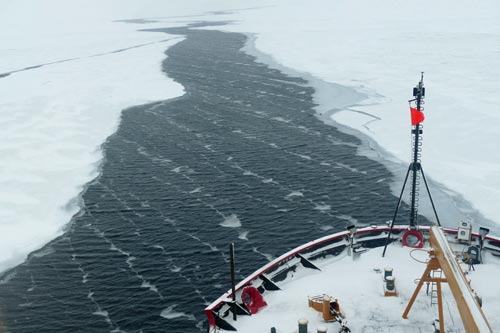 Langmuir circulation cells created a striped look in the open leads today as wind-driven slush was herded into bands by counter-rotating horizontal vortexes in the surface water.
Langmuir circulation cells created a striped look in the open leads today as wind-driven slush was herded into bands by counter-rotating horizontal vortexes in the surface water.
We’ll be transiting for a few days to the next GEOTRACES station, with a couple of short stops for repeat hydrography along the way. There is still work to be done as we go, with many scientists catching up on sample analysis from the last station. For example, there are still plenty of ice cores in the big walk-in freezer that need to be thawed so their water can be filtered and studied. Ana Aguilar-Islas and Rob Rember from the University of Alaska, Fairbanks have a neat system where they can put their trace-metal clean ice cores into vertical plastic cylinders to thaw and then decant the water through filters into vessels for distribution to the different teams needing these samples. The whole process can take place without ever touching the ice or water to keep it free of contamination.
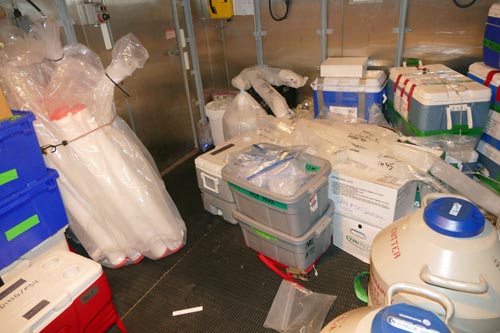 A large walk-in freezer keeps ice cores solid until researchers can get to them for study. The large blue-lidded containers in the lower right are Dewar flasks of liquid nitrogen used in the arsenic analysis process.
A large walk-in freezer keeps ice cores solid until researchers can get to them for study. The large blue-lidded containers in the lower right are Dewar flasks of liquid nitrogen used in the arsenic analysis process.
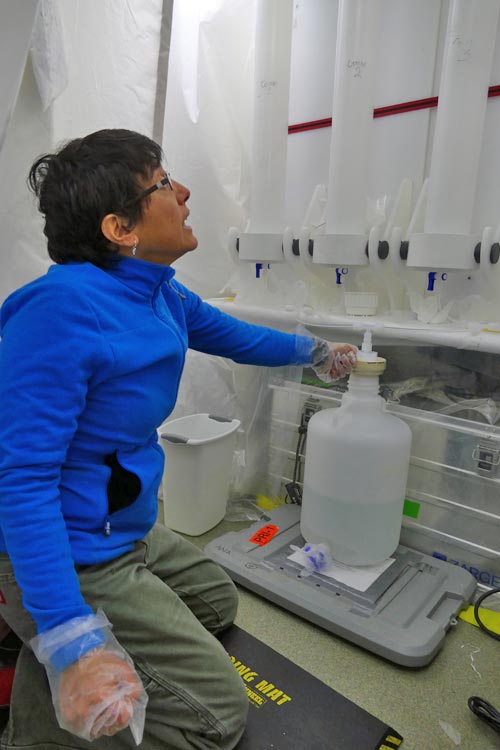 Ana Aguilar-Islas decants filtered trace-metal clean water from thawed ice cores that were left in the white plastic cylinders above her carboy to melt.
Ana Aguilar-Islas decants filtered trace-metal clean water from thawed ice cores that were left in the white plastic cylinders above her carboy to melt.
GO DEEPER!
Why doesn’t the falling snow melt when it lands in the open water leads that we’ve been crossing today?
Aloft Con web cam updated every hour
Healy Track
That's all for now. Best- Bill

